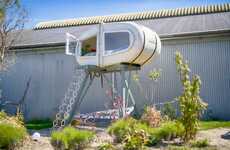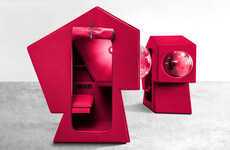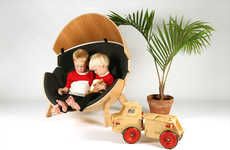
The Sleeping Pod is a Dorm Room Contained in a Surprisingly Small Space
Rahul Kalvapalle — May 20, 2015 — Art & Design
References: cannondesign & gizmag
The Sleeping Pod is a compact living unit, developed by the Yazdani Studio of international design firm CannonDesign, that will serve as compact living spaces for the University of Utah's Lassonde Studios. A total of 80 pods will be included in the Lassonde Institute's hacker space.
The Sleeping Pods are built from interlocking plywood with fiberglass outer shells. They are equipped with hook-ups that can be plugged into the air conditioning, electricity and water connections. The units can be shifted around if needed using a container dolly or pallet jack.
The standard layout version of the Sleeping Pod offers room for all the elements of a typical dorm room. This project proves that stylish compact living is absolutely achievable without compromising on qualify of life, and indeed while boosting it.
The Sleeping Pods are built from interlocking plywood with fiberglass outer shells. They are equipped with hook-ups that can be plugged into the air conditioning, electricity and water connections. The units can be shifted around if needed using a container dolly or pallet jack.
The standard layout version of the Sleeping Pod offers room for all the elements of a typical dorm room. This project proves that stylish compact living is absolutely achievable without compromising on qualify of life, and indeed while boosting it.
Trend Themes
1. Compact Living - The trend of compact living spaces is disrupting traditional dorm room designs, creating opportunities for innovative and space-saving solutions.
2. Modular Furniture - Modular furniture designs are revolutionizing the way we utilize small living spaces, offering versatility and customization options for compact dorm rooms.
3. Sustainable Housing - The development of eco-friendly and sustainable dorm room solutions is transforming the way universities approach student housing, presenting opportunities for disruptive innovation in the industry.
Industry Implications
1. Interior Design - The interior design industry can capitalize on the trend of compact living spaces by creating innovative and functional furniture designs tailored for small dorm rooms.
2. Architecture - Architects have the opportunity to reimagine and redesign traditional dorm room layouts, incorporating modular and sustainable features to optimize space utilization.
3. Real Estate - Real estate developers can explore the market potential of compact student housing solutions, providing affordable and efficient living spaces for universities.
1.7
Score
Popularity
Activity
Freshness























